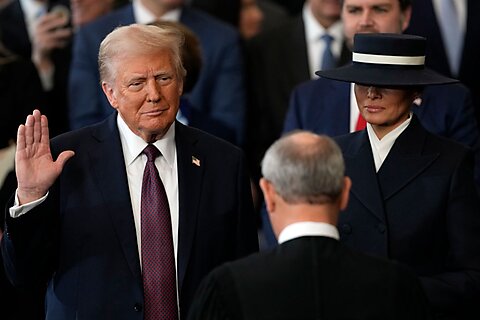
Walter Olson
Since taking office in January, President Donald Trump has used presidential power, both lawfully and otherwise, to overawe many of the alternative power centers in American society, from universities to the legal profession to the media. He has been somewhat more cautious thus far about trying to push around state governments, which, under our Constitution, pose a unique and formidable check to federal power distinct from that supplied by the separation of powers between the three federal branches.
But a High Noon showdown may be coming. Earlier this month CNN reported that the Trump administration “is preparing to cancel a large swath of federal funding for California:
Agencies are being told to start identifying grants the administration can withhold from California. Sources said the administration is specifically considering a full termination of federal grant funding for the University of California and California State University systems.
“No taxpayer should be forced to fund the demise of our country,” White House spokesman Kush Desai said in a statement Friday afternoon, criticizing California for its energy, immigration and other policies. “No final decisions, however, on any potential future action by the Administration have been made, and any discussion suggesting otherwise should be considered pure speculation.”
There have been preliminary skirmishes. Early on, Trump threatened to withhold response funds from California after the catastrophic Palisades and Altadena fires unless it enacted a voter ID law, but soon backed off, whether on advice of counsel or in response to public revulsion. Trump appointees cut off some federal funds to the state of Maine over its handling of trans athletes in schools, a dispute that settled following a federal judge’s ruling in favor of the state.
This spring, Trump ordered the Election Assistance Commission to withhold federal funds from states that did not adopt a ballot receipt deadline of Election Day as part of an executive order seeking to encroach on election powers constitutionally reserved to the states and Congress. A federal judge in California this month struck down that and several other portions of the order. (Another federal judge in April had found a challenge to defunding premature at that point.)
State justice systems have been targets of Trump’s wrath as well. Last month, he said he was directing the US Department of Justice to “take all necessary action to help secure the release of” former Mesa County clerk Tina Peters from jail in Colorado, and an investigation has followed. A jury convicted Peters on seven counts, four of them felonies, after she enabled illegal access to county voting machines in hopes of helping Trump’s cause; Trump’s constitutional pardon power cannot help her since she was convicted under state law. Local Colorado allies of Peters have urged Trump to hold back federal funding to the state to pressure Gov. Jared Polis to pardon her, though there have been no reports yet (so far as I know) of the administration taking any such tangible steps.
Funding threats aren’t the only kind of coercive pressure. On immigration policy, Trump administrators have suggested that state governors as well as big-city mayors could be charged and taken into custody for frustrating the goals of federal law, whether by “obstructing” its enforcement or by “harboring” illegal migrants. (States like California and Illinois have denied that they are doing either of those things.) On June 9, Trump suggested that border czar Tom Homan arrest California Gov. Gavin Newsom, though Homan has put the brakes on that idea for now.
But Trump’s favorite leverage, because it is typically the most powerful, remains unilateral holdbacks of federal funding. The attraction is that doing so can quickly cripple the operations of a target institution, and thus perhaps force it to the negotiating table before it can get a court ruling on whether the federal government’s demands are proper.
On this point, though, Trump runs smack into the Constitution. In neither the university case nor that of the states does that document permit the government to use such threats to coerce targets into surrendering certain essential constitutional rights. On the university side, this is the central issue in the case of Harvard v. HHS, in which my own Cato Institute joined an amicus brief this month along with the ACLU and six ideologically diverse legal advocacy organizations. And while states enjoy fewer rights than do private entities on topics like First Amendment law, the Supreme Court has found that the Constitution guarantees them distinctive protections against the trampling of their proper sovereign sphere. As I noted earlier this year,
[T]he Supreme Court’s Spending Clause jurisprudence provides serious limits on Washington’s power to make states dance to its tune by attaching conditions to funding. Congress must have provided clear notice of the strings in question; the condition must be related to the underlying purpose of the spending … the level of funding threat must not be serious enough to “coerce” the state; states and their agencies must not wind up “commandeered”; and so forth. Trump and his administration often act as if they had never heard of these constitutional constraints.
Writing in the Washington Post, Mitchell Berman of the University of Pennsylvania notes that justices across the spectrum have agreed on the wider point:
Conservatives have historically been at least as vigilant as liberals in guarding against the selective granting and withholding of government benefits as a tool to pressure right-holders into exercising their rights the government’s preferred way. Take the Affordable Care Act decision from more than a decade ago. The Supreme Court invalidated a portion of the act that conditioned all Medicaid funding on states’ agreement to partner with the feds to provide health care to a new beneficiary class. Chief Justice John G. Roberts Jr. rightly reasoned that it was unconstitutional for Congress “to penalize States that choose not to participate in that new program by taking away their existing Medicaid funding” — even though, unquestionably, Medicaid funding is a privilege, not a right.
A quarter-century earlier, the court held that a state zoning authority could not leverage its control over land-use variances (also a privilege, not a right) to pressure a family into conveying a public easement across its private beach. To threaten to withhold permits because of how landowners exercise their property rights, Justice Antonin Scalia reasoned, was “an out-and-out plan of extortion.”
Colleague Ilya Somin agrees with Berman on the relevance of this history:
A standard response to criticisms of such policies that people have no right to these grants in the first place. Receiving federal grants and other government benefits, it is said, is a “privilege, not a right.” Thus, the federal government can impose whatever conditions it wants on recipients.
The courts have long taken the better view: the government cannot selectively extend and withdraw privileges to get people and organizations, in Somin’s words, “to give up their constitutional rights or submit to constraints that go beyond the constitutional authority of the federal government.”
Yesterday, as this post was ready to go to press, a federal court in Rhode Island issued a preliminary injunction in a suit filed by twenty states challenging a Transportation Department edict requiring them to pledge cooperation with federal immigration policy as a condition of receiving transportation grants. The court said the edict would probably be found in violation of the Spending Clause as well as the Administrative Procedures Act.
If Trump tries to pull a Harvard-style comprehensive defunding of California or some other state, the courts will almost certainly stand in his way.
(Cross-posted from my Substack.)






